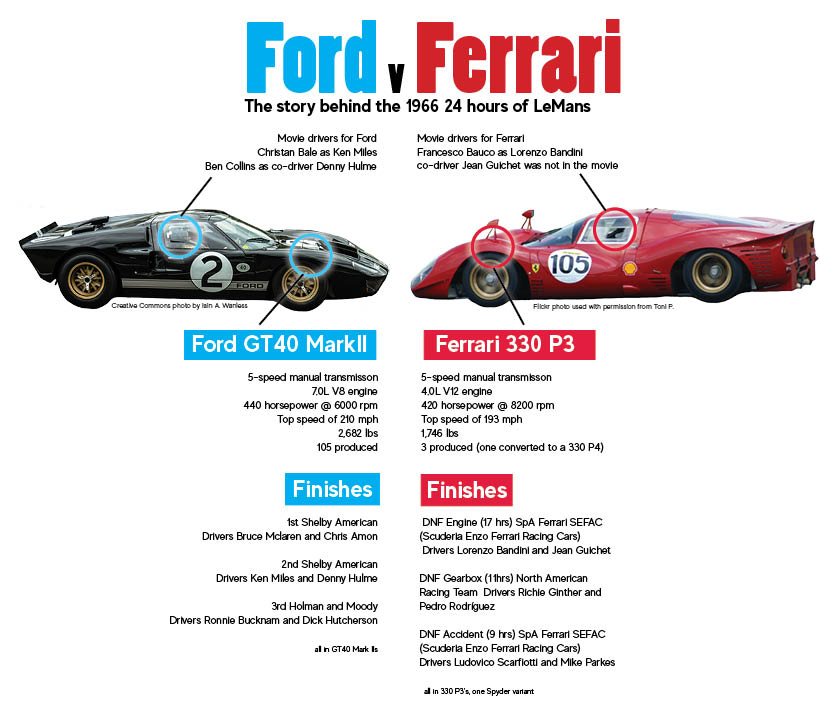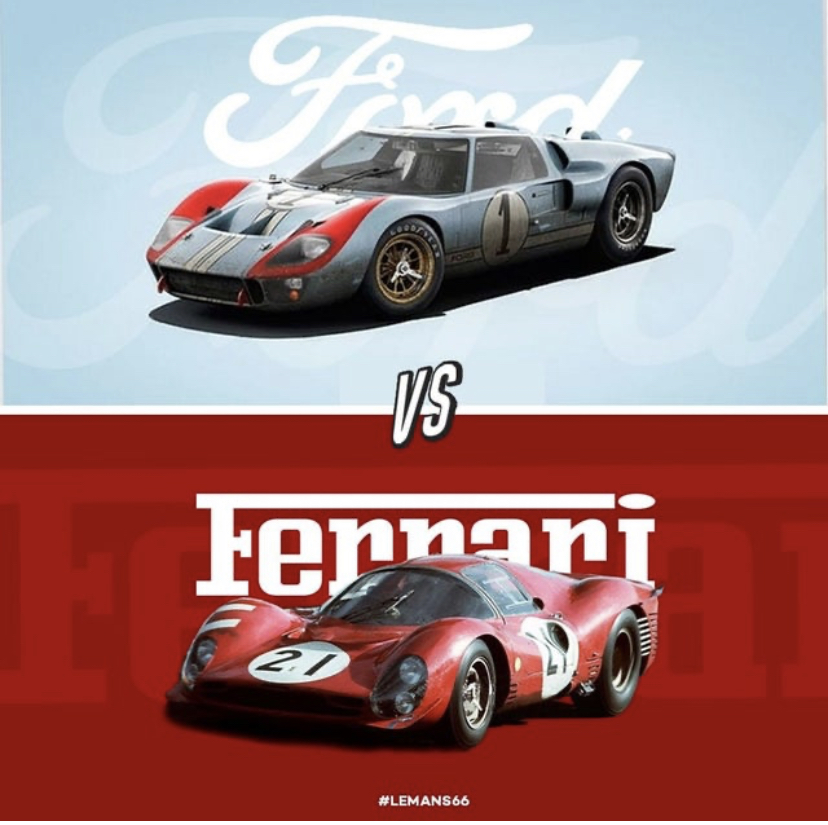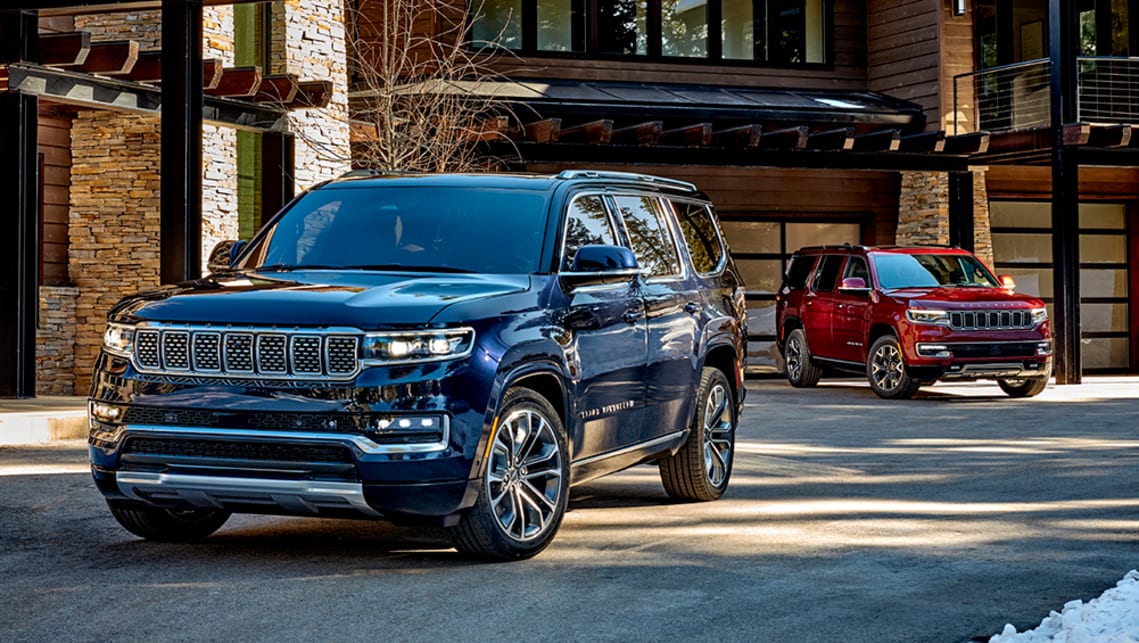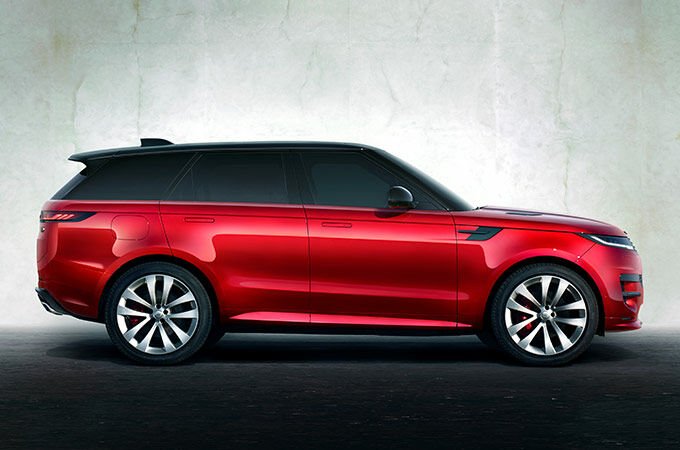The automotive industry is competitive by nature but some carmakers feud more intensely than others.
Racing is often the source of the conflicts that seep into showrooms and enthusiasts have a tendency of escalating them by taking sides. With that said, rivalries are ultimately good for motorists because they force companies to surpass themselves year after year.
We’re taking a look at some of the greatest and longest-standing conflicts the automotive industry has ever seen. Some are good-natured but a few got messy
Bentley vs. Rolls-Royce
Rolls-Royce owned Bentley from 1931 to 1998 so the two companies competed on friendly grounds; their cars often used many of the same parts. Bentley began moving in a sportier direction after British defense equipment firm Vickers took over both brands in 1980 but it didn’t truly blaze its own path until it joined the Volkswagen empire in 1998. Rolls-Royce was briefly part of it, too, though a complicated latticework of deals to do with the Rolls-Royce name – still owned by the company that makes airplane engines – put it under BMW’s watch.
Bentley vs. Rolls-Royce
22 years after the messy split, these two icons of British luxury have become bitter rivals in a number of market segments, including the hotly-contested SUV market. Bentley’s Mulsanne (previous picture) and Rolls-Royce’s Phantom (pictured) are among the most luxurious four-door models in the world but reports claim the former isn’t long for this world. It’s about to leave the line-up after a long production run and it might be replaced by an SUV, a move that would leave the Phantom in a class of one, for now at least.
BMW vs. Mercedes-Benz
BMW and Mercedes-Benz spent decades minding their own business. While the former made (and raced) feisty family cars, the latter played in the luxury segment and elevated its image by manufacturing massive limousines driven by the world’s elite. Chinese ruler Mao Zedong wouldn’t have been caught dead drifting a 2002 Turbo around a bend but he happily paraded in a 600 Pullman. The era of détente ended in the 1980s when BMW turned the luxury dial up and Mercedes took a fancy to sportiness. PICTURE: current BMW 5 Series
BMW vs. Mercedes-Benz
The Mercedes-Benz W123 introduced in 1975 and the BMW 5 Series (E28) from 1981 were in opposite corners of the same room. Their successors, the 1985 W124 and the 1987 E34, overlapped in several key areas. This tit-for-tat rivalry continues in 2020 and the lines separating the two companies are blurrier than ever. They know how to set aside their differences when needed, though.
In 2019, Mercedes parent company Daimler and BMW merged their car-sharing programs and announced plans to collaborate on the development of autonomous driving technology, while they are also co-owners of the HERE navigation and mapping company alongside Volkswagen and others.
Bugatti vs. Koenigsegg
The limited-edition Bugatti Veyron was certified as the world’s fastest production car when it reached 267mph in 2010. Koenigsegg toppled it in 2017 by sending an Agera RS to 278mph on a closed, 11-mile stretch of Nevada State Route 160. Bugatti couldn’t let this offensive go unanswered so it started designing an evolution of the Chiron (pictured) capable of effortlessly crushing the new record.
Bugatti vs. Koenigsegg
Bugatti became the first automaker to break the 300mph barrier with a production-bound street-legal car when intrepid test driver Andy Wallace reached 304mph behind the wheel of a Chiron Super Sport 300+ in 2019. The company then exited the top speed race to focus on other projects it hasn’t fully detailed yet.
In 2020, Koenigsegg unveiled an evolution of the Jesko named Absolut (pictured) capable of reaching 330mph, according to computer simulations, but it hasn’t found where to test it yet; the obvious place is the giant Ehra-Lessien location with its 5.4-mile long straight, but as it’s owned by Bugatti’s owner Volkswagen we fear it may not be available for hire. Oddly, Koenigsegg also said its quest for speed is over regardless of whether it manages to snag the crown from Bugatti.
 Cadillac vs. Lincoln
Cadillac vs. Lincoln
America’s best-known luxury car brands have battled for the wallets of well-heeled motorists and government officials for most of their existence. Highly-modified Lincoln models carried American presidents for decades but the White House has mostly been loyal to Cadillac since it took delivery of a bulletproof Fleetwood in 1984. PICTURE: 2021 Cadillac
![]() Cadillac vs. Lincoln
Cadillac vs. Lincoln
Both carmakers learned the hard way that transporting the head of state and his entourage isn’t enough to stay healthy and their image eroded during the 1980s and the 1990s. Ford later admitted it nearly closed Lincoln in the wake of the 2008 financial crisis. In 2020, both brands are slowly but surely returning to relevance by making products that look and feel like luxury cars, not like the cheaper cars they’re often based on. They’re also once again forging their own image instead of trying to copy their German rivals. PICTURE: Lincoln Navigator
Ferrari vs. Ford
At first glance, this rivalry is ludicrous, but hear us out. The rivalry that opposes Ford and Ferrari was comprehensively documented by the recent movie Ford v Ferrari – now on VOD near you – watch it, it’s great, and let’s face it, you have the time. We won’t spoil it for you, but the premise is that Ford tried buying Ferrari, then an independent company, in the early 1960s but its delegation returned to Michigan empty-handed after the negotiations stalled.
Executives then launched a no-holds-barred campaign to defeat and embarrass the Italian firm where it hurts most: on the track. Its first few attempts at victory failed but it finally captured first place in 1966 (pictured) with the help of Carroll Shelby (1923-2012). It won again in 1967, 1968, and 1969. A true blue collar v white collar battle.
Ferrari vs. Ford
Ford unexpectedly rekindled the rivalry when it released the GT, a mid-engined coupe inspired by the Le Mans-winning GT40, in 2015 and announced plans to enter it in the 24 Hours of Le Mans the following year to commemorate its first victory. Its GTE-Pro-spec GT (pictured) narrowly beat Ferrari’s 488 GTE to win first-in-class, though the Porsche 919 Hybrid took first overall. Satisfied with its trophy, Ford announced plans to shutter its factory-backed endurance racing program after the 2019 season.
Ferrari vs. Lamborghini
Ferruccio Lamborghini (1916-1993), a wealthy tractor maker from northern Italy, launched the carmaker that bears his name in 1963 because he was tired of spending money on fixing his Ferrari. Lamborghini was envisioned as Ferrari’s arch nemesis before it even built its first car.
Enzo Ferrari (1898-1988) may not have paid much attention to his rival’s first car, the 350GT, because high-end coupes made by small companies were a dime a dozen at the time but he couldn’t ignore the mid-engined Miura released in 1966; it changed the supercar segment forever. Ferrari’s first mid-engined, 12-cylinder road car arrived in 1973.
Ferrari vs. Lamborghini
The rivalry continues in 2020, much to the delight of enthusiasts who get to see, hear and, for the lucky ones, drive the exotics used as ammunition in this fight. Ferrari is independent, though it was part of Fiat for decades, and Lamborghini has thrived under the Volkswagen umbrella since 1998. But, and it is a but, Lamborghini lacks most of the racing heritage that Ferrari has had since the start.
![]() Peugeot vs. Renault
Peugeot vs. Renault
France’s two largest carmakers have competed in their home country and abroad for over a century. Renault has often come out on top but Peugeot has never been far behind and it grew in size during the 2010s by expanding its portfolio of brands, notably with the recent acquisition of Opel/Vauxhall from GM.
 Peugeot vs. Renault
Peugeot vs. Renault
In 2019, the PSA Group (which owns Peugeot) was France’s biggest car manufacturer but Renault was the best-selling brand. The 208 ended the year as France’s best-seller with 87,285 sales; the Clio (pictured) finished third with 80,079. PSA stretches further upmarket than Renault with its DS brand, but Dacia gives Renault access to the bottom part of the market. PSA’s looming merger with FCA could add a new dimension to the competition, especially as Renault’s alliance with Nissan shows signs of crumbling.
Tesla vs. everyone else
Few took Tesla seriously when it introduced the Lotus Elise-based Roadster in 2006. The pantheon of automotive history is overflowing with start-ups who couldn’t fund their ambitious projects and the industry had every reason to believe that’s where Tesla was headed. Then it released the Model S (pictured), the first car it designed from the ground up, in 2012 and took luxury automakers by complete surprise.
Tesla vs. everyone else
Tesla enjoyed a lucrative monopoly on the premium electric car segment for most of the 2010s; the Taycan, Porsche’s answer to the Model S, wasn’t unveiled until 2019. The competition is waking up and nearly every automaker regardless of where it’s positioned on the spectrum is busily working on at least one electric model aimed at a Tesla. The new Model Y will soon face competition from the Audi Q4, the Fisker Ocean, Ford’s Mustang Mach-E (pictured), the Mercedes-Benz EQA, and the Nissan Ariya, among others.
Alpine A110 vs. Porsche 718 Cayman
Renault ended a decades-long discord with Porsche when it shuttered its Alpine brand in 1995. It dug up the hatchet when it released the second-generation A110 in 2017 and aimed it directly at the 718 Cayman. Both coupes are light, nimble mid-engined machines developed with maximum engagement in mind. The catch is that the A110 is automatic-only while 718 buyers can order a six-speed manual. Another catch is that, at present, you can’t buy an Alpine A110 in America.
Alpine A110 vs. Porsche 718 Cayman
The A110 is one of the fiercest rivals the 718 has ever had to fend off and it’s an admirable opponent. Autocar recently put an A110S head-to-head against a 718 Cayman T and picked the former as the better all-around car, though we noted the Renault bits in the cabin aren’t as nice as Porsche’s.
Audi RS 6 Avant vs. Mercedes-AMG E63
Mercedes-Benz initially didn’t see the appeal of putting a big engine in a car that looks like it belongs in the Ikea parking lot. The success of Audi’s first-generation RS 6 Avant, which traced its roots to the RS 2 Avant released in 1994, changed the company’s mind. It made the E63 available as a long-roof in 2007.
The competition continues 13 years later. The RS 6 Avant and the E63 both use a 4.0-liter, twin-turbocharged engine tuned to send about 600 hp to the four wheels. Autocar concluded the Audi lacks the AMG’s overall engagement but beats it as an everyday car. It’s a very, very close fight.
Audi RS 6 Avant vs. Mercedes-AMG E63
Audi upped the ante in 2019 when it announced plans to sell the fourth-generation RS 6 Avant on the American market, where the E63 has enjoyed an easy monopoly for years. Expanding the rivalry to North America will certainly lead both sides to escalate the horsepower war. Enthusiasts around the world who like to make their Ikea runs as quickly and loudly as possible are in luck.
![]() Chevrolet Camaro vs. Ford Mustang
Chevrolet Camaro vs. Ford Mustang
Ford caught America by surprise when it released the original Mustang in 1964. It was aimed at the Corvair but Chevrolet quickly concluded it needed to develop a new model to counter it. It launched the Camaro in late 1966 and the rivalry between these two nameplates has taken on epic proportions since.
 Chevrolet Camaro vs. Ford Mustang
Chevrolet Camaro vs. Ford Mustang
In 2020, the Mustang and the Camaro are the last pony cars standing; they’re both in their sixth generation. They’re design-led, heritage-laced models available in a dizzying number of configurations. Buyers can order either as a coupe, as a convertible, with a reasonably efficient turbo four or with a huge V8. While they come standard with a manual transmission and rear-wheel drive, they’re available with the same basic 10-speed automatic transmission that Ford and GM – ironically perhaps – developed jointly.
![]() Chevrolet Silverado vs. Ford F-150
Chevrolet Silverado vs. Ford F-150
The Ford F-Series has been America’s best-selling pickup for 43 consecutive years and the best-selling vehicle regardless of body style for the last 38 of those. Chevrolet has attempted to dethrone its rival for over four decades, recently with the Silverado (pictured), and it has come close on several occasions but Ford continues to reign supreme. It sold nearly 900,000 units of the F-Series on the American market in 2019.
 Chevrolet Silverado vs. Ford F-150
Chevrolet Silverado vs. Ford F-150
The F-Series nameplate admittedly encompasses a wide range of models, including heavy-duty trucks like the F-550, but it’s the F-150 that hogs the spotlight. While it’s too early to call 2020’s winner – frankly it’s too early to make a call about just anything right now – looking at 2019 sales data suggests Ford has a much bigger worry than Chevrolet. The Silverado lost the second spot on the chart to Ram’s family of pickups, which posted an 18% year-on-year increase.
Ferrari LaFerrari vs. McLaren P1 vs. Porsche 918 Spyder
Enthusiasts called the Ferrari LaFerrari, the McLaren P1 and the Porsche 918 Spyder (pictured) the holy trinity. Introduced in 2013, 2012 and 2013, respectively, they were among the first production cars to demonstrate that a hybrid drivetrain can be used to generate jaw-dropping performance figures and achieve dizzying acceleration times. They all reached 60mph in under 3.0sec, they were all launched as limited-edition models and they were all spoken for quickly in spite of a seven-digit price tag.
Ferrari LaFerrari vs. McLaren P1 vs. Porsche 918 Spyder
Era-defining hypercars don’t appear on a regular basis so the holy trinity hasn’t been replaced yet. Ferrari, McLaren and Porsche all learned a great deal about how to merge electrification and performance from their respective projects and the lessons drawn have already trickled down to other cars. All three companies are planning to add more hybrids to their range in the early 2020s.
Fiat 500 vs. Mini Hardtop
Volkswagen deserves credit for bringing the retro-styled city car to the forefront of the automotive scene when it released the New Beetle in 1998. BMW-owned Mini then seized a once-in-a-lifetime opportunity to bring England’s most emblematic car into the 21st century. The first-generation Hardtop went on sale in 2001. Fiat fired back when it resurrected the 500 in 2007.
In Europe and abroad, the Hardtop and the 500 (pictured) emerged as the leaders in this blossoming segment of the industry, and both served as the foundation for a growing range of models. The Mini won over motorists with its distinct premium feel while the 500 appealed to those seeking affordable style. Hot-rodded variants of both cars competed for the hearts of enthusiasts.
Fiat 500 vs. Mini Hardtop
Fiat will release the second-generation 500, which is electric-only, in 2021 while Mini is busily developing the fourth-generation Hardtop. The rivalry is set to continue well into the 2020s, Mini’s two-door Hardtop is notably available as an electric car, but the 500 is no longer sold in America.
Ford Bronco vs. Jeep Wrangler
Ford will resurrect the long-dormant Bronco nameplate in 2020 on an off-roader aimed directly at the Jeep Wrangler. We’re surprised it’s taken this long; the Wrangler has been without a direct rival since the first-generation model made its debut in 1986. Toyota’s FJ Cruiser came close but it wasn’t offered with a removable hard top, a defining feature in the constitution of the Wrangler’s character.
Ford Bronco vs. Jeep Wrangler
The countless leaks, reports and spy shots confirm the born-again Bronco will be a true Wrangler competitor. It will arrive as a burly, body-on-frame off-roader with a removable top, two- and four-door variants and a long list of accessories for owners who want to modify it. Its official debut is scheduled for the summer of 2020 and it’s expected to arrive in American showrooms for the 2021 model year.
Ford Falcon vs. Holden Commodore
For generations, the Ford Falcon and GM’s Holden Commodore were Australia’s go-to cars. They were designed locally as big, rear-wheel drive models with ample power and they were available in several different variants. Stand-outs over the years include high-performance V8-powered models, coupes and utes, an Australia-specific body style pegged at the intersection of passenger cars and pickup trucks.
Ford Falcon vs. Holden Commodore
Their popularity began to wane in the 2000s as Australian motorists increasingly turned towards foreign brands (notably Toyota, which made cars locally) and high-riding models. Ford retired the Falcon nameplate in 2016, when it stopped manufacturing cars in Australia. Holden’s Commodore morphed into a badge-engineered Opel Insignia (pictured) and retired at the end of 2019 due to slow sales. The Holden name will die in 2021, bringing this decades-long rivalry to a definitive end.
Honda Accord vs. Toyota Camry
Honda’s Accord (pictured) and Toyota’s Camry have been at odds since the 1980s, especially in the United States. Both rose to the top of America’s sales chart by offering a very similar blend of value, dependability and affordability; they appeal to motorists seeking peace of mind above all. They’re still permanent fixtures on the list of America’s best-selling cars but they’ve been all over the top-10 list in recent years.
Honda Accord vs. Toyota Camry
In 2020, the Accord and the Camry face a common enemy: SUVs. The current-generation models are better than they’ve ever been, and they’re also more exciting to drive than most of their predecessors, yet they were outsold by their high-riding siblings (the CR-V and the RAV4, respectively) in 2019.
Jeep Grand Wagoneer vs. Land Rover Range Rover
Jeep’s Grand Wagoneer (pictured) and Land Rover’s original Range Rover shouldn’t have been rivals. They were born eight years and an ocean apart and designed with a completely different target audience in mind. And yet, in the late 1980s, they briefly overlapped as demand for luxurious, go-anywhere SUVs grew across America. Both models were over a decade old by that point yet they filled demand admirably.
Jeep Grand Wagoneer vs. Land Rover Range Rover
The rivalry greatly diminished during the 1990s. Land Rover gradually moved the Range Rover (pictured) upmarket while Jeep replaced the Grand Wagoneer with the more mainstream-oriented Grand Cherokee. They’ll meet again in the early 2020s when Jeep brings back the storied Grand Wagoneer nameplate with one goal in mind: to give the Range Rover a run for its money around the world.
Land Rover Series vs. Toyota Land Cruiser
Land Rover’s Series I (pictured), II and III models and the different variants of Toyota’s Land Cruisers took thousands of explorers to uncharted and inhospitable places from the 1950s to the 1970s. Their remarkable simplicity made them relatively quick and easy to mend with basic tools and their off-road capacity allowed them to trudge through terrain that stopped other 4x4s dead in their tracks.
![]() Land Rover Series vs. Toyota Land Cruiser
Land Rover Series vs. Toyota Land Cruiser
Land Rover replaced the Series III with the 90/110 (which later became the original Defender) in 1983. Toyota pushed its do-it-all off-roader in a more modern direction when it launched the 70 Series Land Cruiser in 1984; it’s still produced in 2020, against all odds. The all-new Defender unveiled in 2019 doesn’t compete directly with the full-size Land Cruiser but some versions of it fall in the same segment as the smaller Land Cruiser Prado sold in numerous markets around the globe.
 Mitsubishi Lancer Evolution vs. Subaru WRX STI
Mitsubishi Lancer Evolution vs. Subaru WRX STI
The rivalry between these two hallowed nameplates started in the World Rally Championship (WRC). Finnish pilot Tommi Mäkinen won the driver’s championship behind the wheel of a Mitsubishi Lancer Evolution in 1996, 1997, 1998 and 1999 while the Impreza (which wasn’t called WRX STI yet) earned Subaru the constructor’s title between 1995 and 1997. Both companies ultimately left rallying but the rivalry continued on the road and, significantly, in video games during the 2000s.
![]() Mitsubishi Lancer Evolution vs. Subaru WRX STI
Mitsubishi Lancer Evolution vs. Subaru WRX STI
In 2020, the WRX STI (pictured) is the clear winner. It’s still in production, and the next-generation model is around the corner, while Mitsubishi stopped making the Lancer Evolution in 2016. We’ve heard reports the nameplate will return on an SUV but the Evo as we knew and loved it is long dead.








 Cadillac vs. Lincoln
Cadillac vs. Lincoln




 Peugeot vs. Renault
Peugeot vs. Renault





 Chevrolet Camaro vs. Ford Mustang
Chevrolet Camaro vs. Ford Mustang Chevrolet Silverado vs. Ford F-150
Chevrolet Silverado vs. Ford F-150













 Mitsubishi Lancer Evolution vs. Subaru WRX STI
Mitsubishi Lancer Evolution vs. Subaru WRX STI
